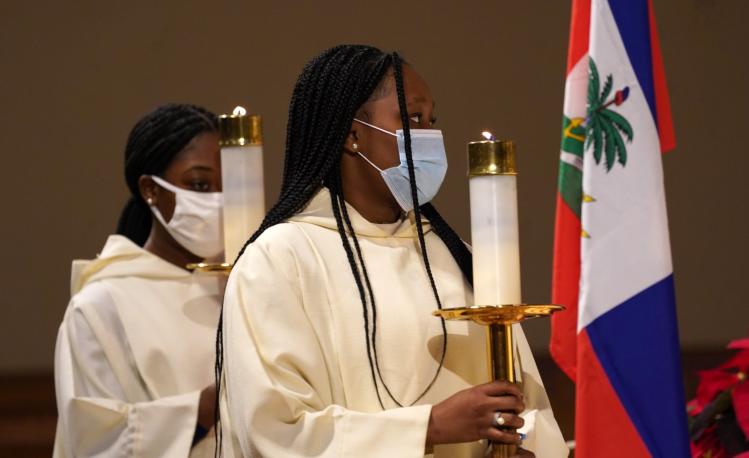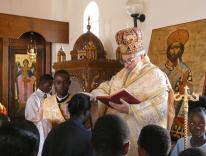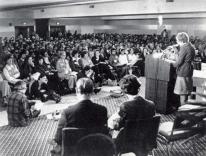
It must be difficult for a mainstream journalist covering the Vatican beat on days like January 11, when Pope Francis’s motu proprio, Spiritus Domini, was announced. How to convey the significance of a tweak to canon law that clarifies women’s eligibility to be lectors and acolytes at Mass? Aren’t they...already doing those things?
Pity the reporter who must quickly explain the existence of “stable ministries” in the Church, and the now-obscure practice of formally instituting lay men into those roles. Even the most committed American Catholics were perplexed when the news broke, because, as Anthony Ruff, OSB, wrote at the Pray Tell blog, “Up until now, females couldn’t be installed in these ministries, but they could do these ministries anyway.” It’s no wonder so many outlets framed the news in terms of what hadn’t happened: “Pope says women can read at Mass, but still can’t be priests” ran a typical headline.
“The Church has no authority whatsoever to confer priestly ordination on women,” Pope John Paul II declared in 1994 in an attempt to shut down that debate. Francis quoted that pronouncement in a letter accompanying Spiritus Domini, but he also wrote that he hoped the change he was making to canon law would help men preparing for ordination “better understand they are participants in a ministry shared with other baptized men and women.” Francis’s modification to one canon—changing “lay men” to “lay persons”—eliminates a long-standing excuse for discrimination against women, although you won’t find him or any other Vatican official putting it in those terms.
Speaking as a non-man, I confess to difficulty in keeping track of when the word “men” is supposed to include me (as in the English translation of the Nicene Creed, “for us men and for our salvation”) and when it is not meant to include me (as in the original language of Canon 230, at least according to those who prefer their liturgical ministers to be male). The truth is, even when the Church’s own teaching clearly declares that it does have the authority to acknowledge, empower, or elevate women, those charged with applying that teaching have always maintained the prerogative of keeping women out. The post–Vatican II teaching that laypeople had a significant role in ministry was undercut by accommodations for bishops who felt women should be subject to special restrictions. In this light, the significance of Pope Francis’s action is less that it expands what women are permitted to do, and more that it limits men’s ability to hinder them.
Establishing and protecting men’s authority and privileges has been the Vatican’s consistent framework for defining women’s roles in liturgy going at least as far back as Liturgicae instaurationes, the document the Congregation for Divine Worship and the Discipline of the Sacraments (CDW) issued in 1970 to govern post-conciliar reforms. In setting the terms of what should be allowed, the CDW wrote, “the first appeal must be made to the authority of the individual bishops.” Bishops, for their part, were encouraged to “use all the options the new rites provide” to determine what did and did not promote “unity” and serve the spiritual needs of their flocks.
One option that was emphatically not provided was permission for women or girls to serve Mass: “In conformity with norms traditional in the church, women (single, married, religious), whether in churches, homes, convents, schools, or institutions for women, are barred from serving the priest at the altar.” On the subject of women reading, the CDW was cautious: “The conferences of bishops are to give specific directions on the place best suited for women to read the word of God in the liturgical assembly.” Why would women, but not lay men, need a special place from which to read Scripture? The simple answer is sexism—or, as they say in Rome, “norms traditional in the church.” The ambo where Scripture is proclaimed is traditionally located in the sanctuary, and the sanctuary is traditionally a male-only space. If you can imagine thinking it would be better to keep the Scriptures outside the sanctuary than to let women in, congratulations, you are thinking like Rome circa 1970.
Happily, the ladies-only lectern seems not to have caught on in U.S. parishes, but it would take a while longer for the idea of altar girls to flip from “barred” to “well, if you must.” In 1980, the CDW issued another document, Inaestimabile donum, which said: “There are, of course, various roles that women can perform in the liturgical assembly: these include reading the Word of God and proclaiming the intentions of the Prayer of the Faithful. Women are not, however, permitted to act as altar servers.” A revision of canon law completed in 1983 held, in the same provision recently modified by Pope Francis, that “lay men” could be admitted to the stable ministries of lector and acolyte, and that “lay persons” could fulfill other liturgical functions. Many interpreted that to mean female altar servers were at last permitted, but not until 1994 did the CDW confirm that that interpretation was correct, and the letter announcing that verdict took pains to clarify that “the permission given in this regard by some bishops can in no way be considered as binding on other bishops.” Canon law might allow women and girls to serve, but nobody could force any bishop to like it. A letter published by the CDW in 2001 spelled out its further findings: “The diocesan bishop...has the authority to permit service at the altar by women within the bounds of the territory entrusted to his care,” but “such an authorization may not in any way exclude men or, in particular, boys from service at the altar nor require that priest of the diocese would make use of female altar servers.” Not only is it up to individual bishops to determine whether “women serving at the altar would truly be of pastoral advantage in the local pastoral situation,” it is also the prerogative of every priest to disregard his bishop’s decision if it happens to be in favor of women serving (but not if it isn’t).
“It is perhaps helpful to recall,” that letter goes on, “that the non-ordained faithful do not have a right to service at the altar.” Still, when boys and men are presumed to have access to this ministry even when women do not, it does seem fair to ask whether lay women have a right to consider themselves on equal footing with lay men.
In this light, Pope Francis’s change to canon law really matters. With this revision, there is at last no asterisk to limit the validity of women’s baptism or the extent of women’s share in the “baptismal priesthood.” The text of Spiritus Domini describes ministries like lector and acolyte as being “entrusted...to individual members of the faithful, by virtue of a particular form of exercise of the baptismal priesthood,” before explaining that language referring to “lay men” has been changed to “lay persons” in order to clarify that all of the baptized faithful are eligible. Ministries that canon law declares open to the non-ordained by virtue of baptism are definitively not limited on account of sex. In an accompanying letter to the Congregation for the Doctrine of the Faith, Francis explains that the change allows for “a clearer manifestation of the common baptismal dignity of the members of the people of God.”
There is, however, a catch. As the change applies only to the stable ministries of lector and acolyte—which, again, have not been much in use in the past fifty years, aside from serving as formal markers in the preparation of men for ordination—it could be argued that it has no effect on the current, widespread practice of lay participation in liturgical ministry or the rules that apply to it. Canon law now says, “Lay persons who possess the age and qualifications established by decree of the conference of bishops can be admitted on a stable basis through the prescribed liturgical rite to the ministries of lector and acolyte.” It remains to be seen whether American dioceses will revive those liturgical rites. At present, the U.S. bishops’ criteria require a candidate to be at least twenty-one years old. A bishop could decide to take the job away from children in favor of a newly established corps of adult lay acolytes—except that the CDW has twice declared that “it will always be very appropriate to follow the noble tradition of having boys serve at the altar.” Bishops could pursue reforms that would allow children to be installed in the “stable ministry” of acolytes. A simpler course would be to continue the custom of allowing children to fulfill the role of altar server with no formal installation. In that case, the provisions that allow bishops and priests to exclude girls would still, arguably, apply.
“The effectiveness of liturgy...[lies] solely in entering more deeply into the word of God and the mystery being celebrated,” the CDW declared in 1970. “It is the presence of these two that authenticates the Church’s rites, not what some priest decides, indulging his own preferences.” And yet, ever since, the extent to which women and girls are permitted to participate in lay ministries at Mass has been left to “what some priest decides, indulging his own preferences.” The Vatican keeps telling bishops that they can allow women to serve. It stops short, even now, of telling them they should. You won’t find an apology accompanying this reform. There is no hint of regret in the pope’s letter that the “baptismal dignity” of women was ever obscured, no suggestion that the exclusion of women was an injustice. No call to repentance; no apology to the women whose faithful service justifies this change; just an acknowledgment that “doctrinal development” now makes it possible to recognize women as people.
According to norms traditional in the Church—that is, so long as women hold no positions of genuine authority—it will always be up to men to decide what they are willing to let women do. Francis’s desire to encourage lay participation in the work of the Church is laudable, and his hope that ordained men will see themselves as partners in priesthood with laypeople is refreshing. But if Francis is less anxious than his predecessors about the idea of women being called to ministry, his motu proprio is still an expression of the authority men retain for themselves. The pope’s modification of canon law has resolved an awkward tension by clarifying that lay ministries are open to lay people, period. It removes a major excuse that men have used to keep women at a distance from the altar of the Lord. But it doesn’t require them to give us anything we don’t already have. Changing canon law in this way doesn’t force ordained men to get used to working with women. At best, it nudges them toward recognizing that they should want to.
Please email comments to [email protected] and join the conversation on our Facebook page.
Previous Story
A Failed Auction
Next Story
Letters | Leading by Example

